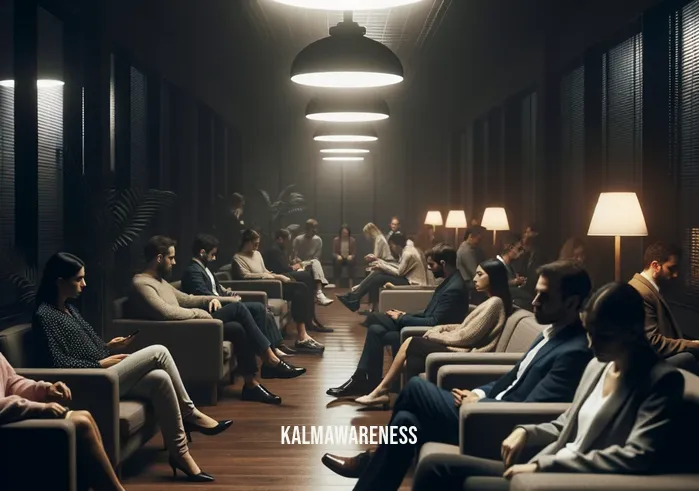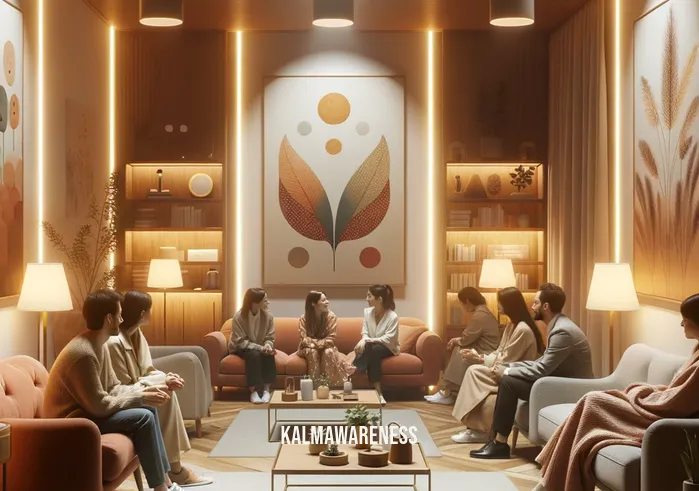The Comfort Zone: Exploring the Therapy Office Waiting Room
Welcome to the world of therapy office waiting rooms, a space where first impressions and comfort play a pivotal role. This section delves into what makes these waiting areas more than just a place to sit before your appointment.
The Unsung Hero of First Impressions
When you step into a therapy office, the waiting room often serves as your first encounter. It’s not just a room; it’s an introduction to the therapeutic journey ahead. This space can significantly influence your comfort level and mindset. From the color of the walls to the arrangement of furniture, every detail contributes to creating an atmosphere of tranquility and safety.
Design Elements That Matter
The Power of Color
Color psychology plays a crucial role in setting the mood of a therapy office waiting room. Soft, calming colors like pastel blues, greens, or neutral tones are commonly chosen to induce a sense of peace and calm. These hues are not just for aesthetics; they’re chosen to help clients begin their journey to mindfulness and inner peace.
Seating: Comfort and Privacy
Comfortable seating is a must, but the arrangement of these seats is equally important. The room should offer a blend of privacy and openness. Chairs and sofas are often arranged to allow clients to choose between solitude and the subtle comfort of others’ presence. This thoughtful arrangement respects personal space while fostering a sense of communal support.
Lighting: Bright Yet Soothing
Lighting in a therapy office waiting room can make a huge difference. Natural light is always preferred, but soft, warm artificial lighting can also create a welcoming ambiance. Harsh fluorescent lighting is often avoided as it can be unsettling and harsh on the eyes.
The Role of Calm Enhancing Elements
Incorporating elements that promote relaxation and mindfulness is a subtle yet effective strategy. This could include:
- Artwork: Carefully selected pieces that evoke tranquility and introspection.
- Indoor plants: Known for their calming effect and air-purifying qualities.
- Reading materials: Books or magazines related to wellness and self-improvement, like “Mindfulness Prescription for Adult ADHD“.
- Soft background music: Tunes that are soothing and not distracting.
Beyond the Physical Space
The waiting room experience is not just about physical comfort. It’s about preparing you for the therapeutic process. A well-designed waiting area subtly communicates care, respect, and understanding. It’s a space where the journey towards healing and self-discovery gently begins.
As you sit in such a thoughtfully designed space, you might find yourself feeling more relaxed, more open to the therapy process. This transition from the outer world to an introspective space is crucial and often begins right here, in the waiting room.
Wrapping Up the Waiting Room Experience
As you leave the comfort of the waiting room and move towards the therapist’s office, you carry with you the calm and readiness instilled in that space. It’s not just a room; it’s the first step in your journey of healing and self-discovery.
Curious about how the therapy process builds upon this initial experience? Stay tuned for the next section, where we dive deeper into the therapeutic journey. But before that, have you ever wondered how the design of a waiting room can impact your therapy experience?

The Therapeutic Ambience: Delving Deeper into the Waiting Room Experience
Continuing our journey through the therapy office waiting room, let’s delve deeper into how this space facilitates a smooth transition into the therapeutic environment. This section examines the subtle yet powerful elements that contribute to a patient’s overall experience.
The Psychology Behind the Space
Crafting a Safe Harbor
A therapy waiting room is more than just a physical space; it’s a psychological sanctuary. It’s designed to be a buffer zone between the outside world and the therapist’s office, a place where clients can mentally prepare for their session. The careful balance of privacy and openness, soothing colors, and comfortable seating all contribute to making clients feel safe and supported.
Sensory Engagement and Mindfulness
The waiting room is often equipped with elements that engage the senses in a soothing manner. Soft background music, the subtle scent of essential oils, or the calming visuals of artwork and plants – these elements work in harmony to create a mindful atmosphere. This sensory engagement helps clients to become more present and grounded, a crucial step before delving into therapy.
The Impact on the Therapy Process
Transitioning from External to Internal
As clients spend time in the waiting room, they begin the subtle transition from focusing on the external world to turning inward. This shift is essential for a successful therapy session. By the time clients leave the waiting room, they are often more centered and ready to engage deeply in the therapeutic process.
Building Trust and Comfort
First impressions matter. A well-thought-out waiting room can help build trust in the therapist and the therapeutic process. When clients feel cared for in the waiting room, it sets a positive tone for the therapy session itself.
Structured Insights: Elements of an Effective Waiting Room
| Element | Purpose | Impact on Client Experience |
|---|---|---|
| Color Scheme | Sets mood and atmosphere | Induces calmness and comfort |
| Seating Arrangement | Balances privacy and openness | Enhances sense of safety and choice |
| Sensory Elements (Music, Scents, Art) | Engages senses gently | Promotes mindfulness and presence |
| Reading Materials | Offers mental engagement | Prepares mind for introspective work |
The Digital Dimension: Websites and Mobile Apps
In today’s digital age, the waiting room experience often begins before the client even steps foot in the office. Therapists’ websites and mobile apps play a crucial role in setting expectations and building a connection. These digital platforms can offer resources like articles on mindfulness practices, such as “Mindful Movement Sleep” or “EMDR Meditation”. This pre-appointment engagement further enhances the client’s readiness for therapy.
Concluding Thoughts: Beyond the Waiting Room
As we conclude our exploration of the therapy office waiting room, it’s clear that this space plays a significant role in the therapeutic process. From the color of the walls to the digital presence, every element is purposefully designed to facilitate a smooth transition into therapy.
This leads us to ponder: How does the design of the waiting room reflect the therapist’s approach to care? What other subtle cues in the therapy office can impact our journey towards healing and self-discovery? Stay tuned for the final section, where we explore these intriguing questions and more.

Beyond the Waiting Room: Envisioning a Holistic Therapeutic Experience
As we conclude our exploration of the therapy office waiting room, let’s integrate the insights gathered and envision how these principles can be applied beyond the confines of this space, contributing to a holistic therapeutic experience.
The Reflection of Therapeutic Philosophy
A Mirror to the Therapist’s Approach
The design and atmosphere of the waiting room often reflect the therapist’s approach to care. A mindfulness-focused therapist might incorporate elements like meditation cushions or resources on mindful practices, such as “Floating Meditation” or “Inner Child Healing Exercises”. This alignment between space and therapeutic technique can deepen the client’s engagement with the therapy process.
Future Directions: Evolving Waiting Room Dynamics
Technology Integration
Looking ahead, we can anticipate more integration of technology in therapy waiting rooms. Digital check-ins, virtual reality relaxation experiences, or interactive apps offering pre-session activities are just a few possibilities. These advancements could further personalize and enhance the waiting room experience.
Community Building
Another potential evolution is transforming waiting rooms into community spaces. Group activities, wellness workshops, or peer-led discussions could be facilitated, offering clients additional support and connection.
Actionable Insights for Therapists and Clients
For Therapists:
- Continuously evaluate and update the waiting room to reflect current therapeutic practices and client needs.
- Consider client feedback in the design to ensure it resonates with their experiences and expectations.
For Clients:
- Use the waiting room time for mindful practices or self-reflection, preparing mentally for the session.
- Engage with available resources to enhance understanding and comfort with the therapeutic process.
Engaging Call-to-Action for Further Learning
To deepen your understanding of how environment impacts therapy, consider exploring resources such as “Mindfulness Prescription for Adult ADHD” or “Meditation for Dummies”. These resources can provide valuable insights into integrating mindfulness into your daily life, including therapy sessions.
Concluding Thoughts and Reader Reflection
As we wrap up our discussion on the therapy office waiting room, consider how your environment influences your mental and emotional state. What elements in a waiting room make you feel most at ease? How could these principles be applied in your own living or working space to promote well-being?
Key Insights Summarized:
- Design Reflects Care: The waiting room’s design mirrors the therapist’s approach and sets the tone for the therapy session.
- Sensory Engagement: Thoughtful sensory elements in the room can enhance mindfulness and readiness for therapy.
- Future Possibilities: Technological advancements and community-focused activities could revolutionize waiting room experiences.
- Actionable Steps: Therapists and clients can use the waiting room as a tool for enhancing the therapeutic experience.
In conclusion, the therapy office waiting room is more than a space to pass time before a session. It’s a crucial component of the therapeutic journey, offering a unique opportunity to prepare, reflect, and transition into a state of mindfulness and openness. The insights and practices within this space can extend into our daily environments, promoting a continuous journey of self-awareness and healing.



